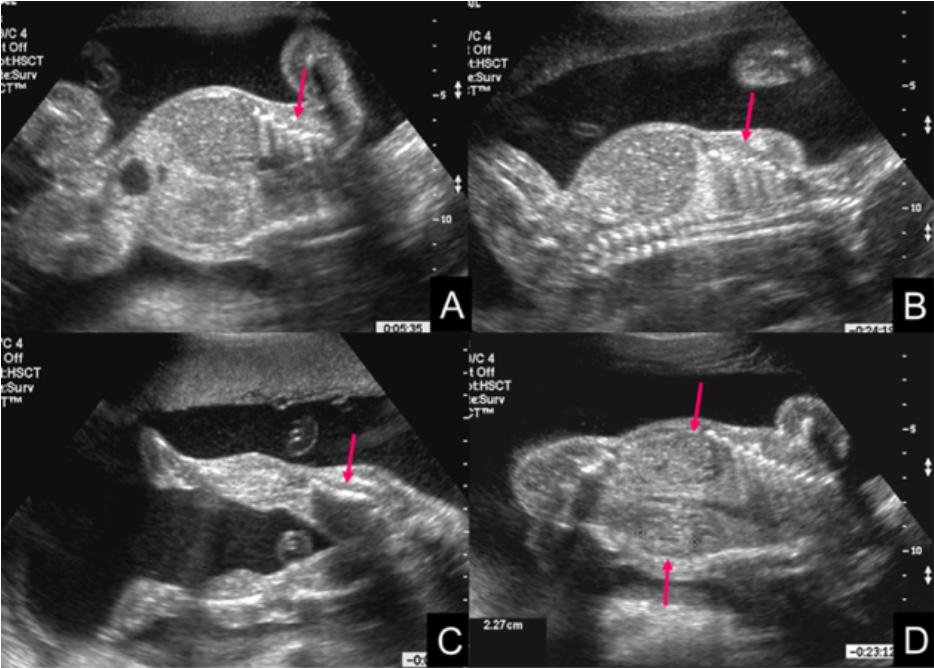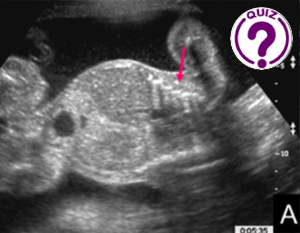
Webinar: WFUMB Centre of Education Timisoara-Romania, Meets WFUMB Centre of Education, China – 25 June 2024
May 8, 2024
ASUM New Zealand 2024 Annual Conference
May 30, 2024Jeong Yeon Cho
Department of Radiology, Seoul National University Hospital, Seoul, Korea
* Correspondences: radjycho@snu.ac.kr
Clinical history
A 31-year-old pregnant woman was referred to our department at 24 weeks’ gestation for second-line evaluation of a fetal anomaly detected at a routine antenatal ultrasound examination. Her personal and family medical history were unremarkable.
Images

Figure1. Ultrasound findings of a fetus at 24 weeks’ gestation.
A & B. Coronal (A) and sagittal (B) scans of fetal chest and abdomen show narrow thorax (arrows) and protruding abdomen.
C. Coronal scan of the lower extremities reveals moderate shortening of both femurs (arrow) without bowing or fracture.
D. Coronal scan of the fetal abdomen shows abnormal echogenicity of both kidneys with micro-cystic changes (arrows).
Quiz-summary
0 of 1 questions completed
Questions:
- 1
Information
View the May/June Case below, answer the question and then click check >
You have already completed the quiz before. Hence you can not start it again.
Quiz is loading...
You must sign in or sign up to start the quiz.
You have to finish following quiz, to start this quiz:
Results
0 of 1 questions answered correctly
Your time:
Time has elapsed
You have reached 0 of 0 points, (0)
Categories
- Not categorized 0%
- 1
- Answered
- Review
-
Question 1 of 1
1. Question
Question: Which diagnosis do you consider?
Correct
CORRECT ANSWER EXPLAINED BELOW Correct answer is: Asphyxiating thoracic dysplasia
Discussion
Asphyxiating thoracic dysplasia, also known as Jeune syndrome, is an autosomal recessive disease with an estimated incidence of 1:100,000-130,00 live births (1). It is a type of rare short limb skeletal dysplasia, which is primarily characterized by a constricted long narrow thoracic cavity, cystic renal dysplasia and moderately shortened long bones.
The prognosis can be variable as a result of the marked phenotypic variation. Some reports indicate that 50-60% of children with asphyxiating thoracic dysplasia die in infancy or during the first few years after birth (2). In those who survive birth, severe pulmonary symptoms will be present in the first year of life. There can be an improvement in the skeletal and thoracic deformities with a relative growth of the thoracic cage after birth. The increased mortality is mostly due to compromised respiration.
Multiple surgical techniques have been described for treatment of thoracic hypoplasia with the primary objective being the expansion of thoracic volume, which can in turn allow improved lung expansion and ventilation. Most of the approaches include median sternotomy with graft interposition (3).
Conclusion
Asphyxiating thoracic dysplasia is an extremely rare congenital disorder with a spectrum of abnormalities of which thoracic hypoplasia is the most striking. It can be diagnosed on early antenatal US by its characteristic skeletal and morphological features which can guide further management of the pregnancy either to termination or to preparation for surgical correction of the deformity (4).
Conflicts of Interest
The authors declare no conflict of interest.
References
- Chen H. 2004. Asphyxiating thoracic dystrophy (Jeune syndrome). eMedicine [http://emedicine.medscope.com/article/945537-overview]: 1–12
- Keppler-Noreuil KM, Adam MP, Welch J, Muilenburg A, Willing MC. Clinical insights gained from eight new cases and review of reported cases with Jeune syndrome (asphyxiating thoracic dystrophy). Am J Med Genet Part A. 2011;155:1021–1032.
- Phillips JD, van Aalst JA. Jeune’s syndrome (asphyxiating thoracic dystrophy): congenital and acquired. Semin Pediatr Surg. 2008;17(3):167–72.
- Mistry KA. Suthar PP, Bhesania SR. Patel A. Antenatal diagnosis of Jeune dyndrome (Asphyxiating Thoracic Dysplasia) with micromelia and facial dysmorphism on second-trimester ultrasound. Pol J Radiol. 2015; 80:
Incorrect
CORRECT ANSWER EXPLAINED BELOW Correct answer is: Asphyxiating thoracic dysplasia
Discussion
Asphyxiating thoracic dysplasia, also known as Jeune syndrome, is an autosomal recessive disease with an estimated incidence of 1:100,000-130,00 live births (1). It is a type of rare short limb skeletal dysplasia, which is primarily characterized by a constricted long narrow thoracic cavity, cystic renal dysplasia and moderately shortened long bones.
The prognosis can be variable as a result of the marked phenotypic variation. Some reports indicate that 50-60% of children with asphyxiating thoracic dysplasia die in infancy or during the first few years after birth (2). In those who survive birth, severe pulmonary symptoms will be present in the first year of life. There can be an improvement in the skeletal and thoracic deformities with a relative growth of the thoracic cage after birth. The increased mortality is mostly due to compromised respiration.
Multiple surgical techniques have been described for treatment of thoracic hypoplasia with the primary objective being the expansion of thoracic volume, which can in turn allow improved lung expansion and ventilation. Most of the approaches include median sternotomy with graft interposition (3).
Conclusion
Asphyxiating thoracic dysplasia is an extremely rare congenital disorder with a spectrum of abnormalities of which thoracic hypoplasia is the most striking. It can be diagnosed on early antenatal US by its characteristic skeletal and morphological features which can guide further management of the pregnancy either to termination or to preparation for surgical correction of the deformity (4).
Conflicts of Interest
The authors declare no conflict of interest.
References
- Chen H. 2004. Asphyxiating thoracic dystrophy (Jeune syndrome). eMedicine [http://emedicine.medscope.com/article/945537-overview]: 1–12
- Keppler-Noreuil KM, Adam MP, Welch J, Muilenburg A, Willing MC. Clinical insights gained from eight new cases and review of reported cases with Jeune syndrome (asphyxiating thoracic dystrophy). Am J Med Genet Part A. 2011;155:1021–1032.
- Phillips JD, van Aalst JA. Jeune’s syndrome (asphyxiating thoracic dystrophy): congenital and acquired. Semin Pediatr Surg. 2008;17(3):167–72.
- Mistry KA. Suthar PP, Bhesania SR. Patel A. Antenatal diagnosis of Jeune dyndrome (Asphyxiating Thoracic Dysplasia) with micromelia and facial dysmorphism on second-trimester ultrasound. Pol J Radiol. 2015; 80:

